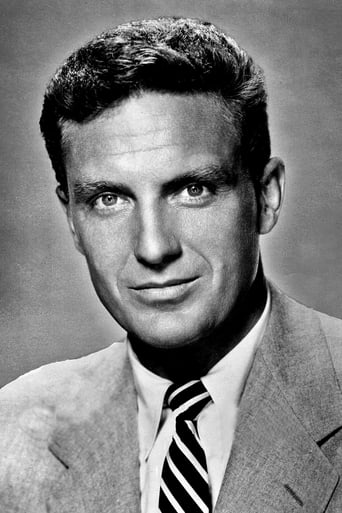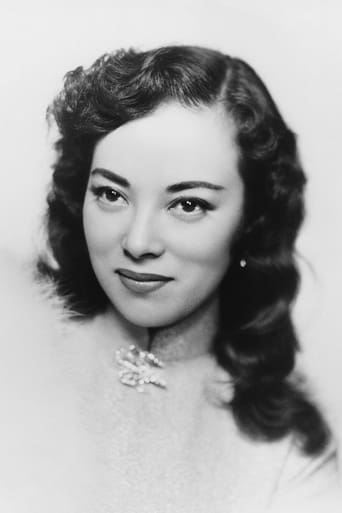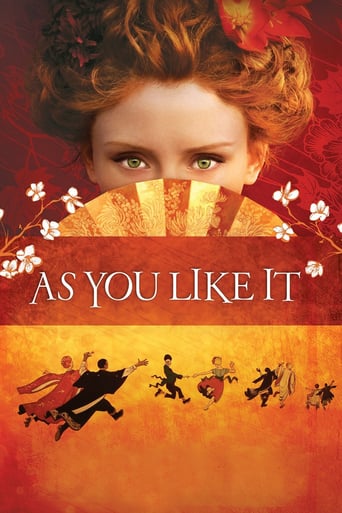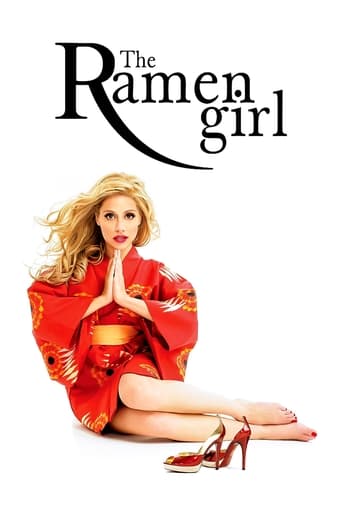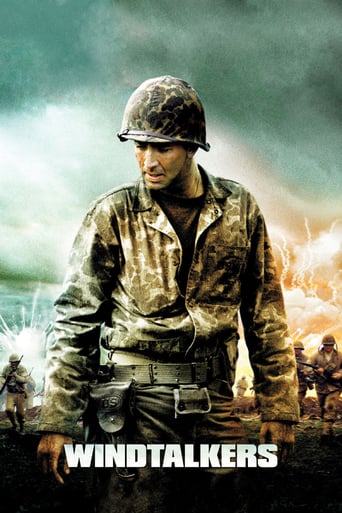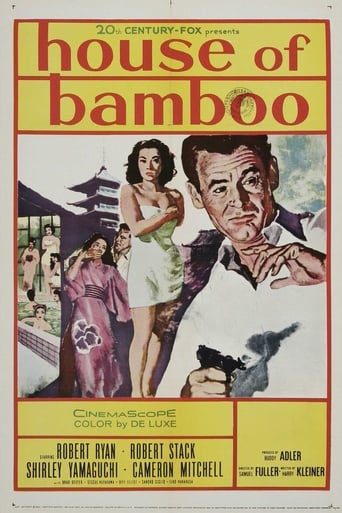

House of Bamboo (1955)
Eddie Kenner is given a special assignment by the Army to get the inside story on Sandy Dawson, a former GI who has formed a gang of fellow servicemen and Japanese locals.
Watch Trailer
Cast


Similar titles
Reviews
Touches You
Good concept, poorly executed.
Fresh and Exciting
Don't listen to the negative reviews
Viewed on DVD. Cinematography = ten (10) stars; locations =ten (10) stars; subtitles = one (1) star. Director Samuel Fuller presides over a film that is mostly a disaster. The plot is pedestrian (American Yakusa (all former U.S. military personnel) doing business in Tokyo), the script is unimaginative (lines seem to be invented by bored actors), the protagonist roles are miscast (see below), and directing and editing are uneven and jumbled (continuity between scenes appears to be an after thought). The movie's title seems to have been picked out of a hat; it bears no relationship to the story. The real stars of this photo play are it's: (1) cinematography (Cinemascope, color) which is simply beautiful (Fuji-San (Mount Fuji) is stunning and never looked better in the winter) and extremely imaginative; and (2) on-location scenes showing what Tokyo looked like about 10 years after the war. The latter provides a fascinating, time-capsule view of street and dock life. (Just ignore the relocation of the colossal Daibutsu (Great Buddha) from Kamakura to Tokyo!) One lead actor is over the hill and it clearly shows; the other lead actor provides a stiff-as-a-board performance (which became his trademark). The part of the Japanese "kimono girl" calls for a Japanese-Japanese actress, not an Americanized-Japanese actress who is also too old for the role. The film score is okay, but not very imaginative. There are no subtitles for Japanese line readings which are frequent and can be rather long. Highly not recommended! WILLIAM FLANIGAN, PhD.
Robert Ryan, with his steely eyes, runs a gang of armed robbers in Tokyo like a squad of infantrymen. Every hold up is planned carefully. If a man is wounded in battle, he's executed by his comrades so he can't spill the beans to the enemy. A polite and well-dressed but very stern taskmaster.Enter Robert Stack in crummy trench coat, beat-up fedora, and the kind of day-old stubble that has now become fashionable but was a sign of moral decay in 1955. What a nasty guy. He wanders around Tokyo plying the extortion racket, busting furniture, snarling and being rude to the courteous Japanese, including the attractive young woman he hooks up with, Shirley Yamaguchi.Ryan finds out about this interloper and summons him by having him thrown through one of those paper walls in Japanese structures. A bit of dialog back and forth as Ryan explains, clearly, that HE is running the rackets here. But then, for some reason, he takes a liking to the brutish Stack and adopts him into the gang, soon promoting him to executive officer, which alienates the hell out of the previous occupant, Cameron Mitchell, who takes to drink and becomes unreliable.Of course, Stack is not a hoodlum. He's a mole, some kind of operative for the military, and he reports back to the police on Ryan's plans. Ryan blames the erratic Cameron Mitchell and administers a one-man firing squad with his pistol as Mitchell is sitting in a hot tub. It's a freakish scene. Ryan bangs open the door, strides in, and begins emptying his clip without a word, while Mitchell lets out a shriek and rises half way out of the tub like Nijinsky. "I could never understand how a man can betray his friends," muses Ryan.This is a remake of "Street With No Name," starring Mark Stevens and directed by William Keighley at Fox. The original is superior to the remake for a number of reasons."House of Bamboo" belongs to a genre that flourished briefly during the early 50s when many American troops were stationed in Japan. It influenced pop music: "Gomenasai" was a hit. The movies thought they were introducing the audience for the first time to the quaint customs of the Far East -- "Sayonara," "Yakuza", and some others I forget. Gee, they eat with chopsticks and sleep on the floor.The same photographer, Joe MacDonald, was used on both movies but I don't know. Maybe he aged. The original was marvelously done, full of sinister shadows and stark lights. Here everything, inside and out, is flat and shot in high key like an episode of "I Love Lucy." As the gang leader, Richard Widmark had more character than the smiling Robert Ryan, although there was less of a homoerotic undertone. Widmark was truly individualized, hateful, sneering, pompous and given to the use of a nasal inhaler. Robert Ryan is not a less competent actor than Widmark but the script doesn't give him very much to play with.In the original, Mark Stevens never practiced celluloid magic. Robert Stack, alas, is sullen throughout, both when he's pretending to be a gangster and later, when his real identity is revealed. It's ironic that in live interviews, Stack was an interesting man -- devoted skeet shooter, humorous, lively, expressive, and ready to laugh. When the cameras rolled he turned into lignite, his expression fixed, as on a death mask. His inability to express himself on screen was put to good use when he played serious fools in the "Airplane" movies.The climactic shoot out is handled better in Fuller's film than in the original. It's spectacular, actually, although both are pretty effective.
Samuel Fuller's "House Of Bamboo" is a violent crime thriller which initially makes a strong impact because its visual style is so radically different to that seen in his earlier film noirs. Whilst Fuller's normal directness, lack of sentimentality and well staged action sequences are all in strong evidence, the use of cinemascope and colour photography add a new dimension and create a very fresh and stunning backdrop to the action.This movie (which is a remake of "The Street With No Name") was the first Hollywood film to be made in post-war Japan and is remarkable for how successfully it captures the splendour of the local landscape and how well it integrates its beautifully photographed location footage into a story which is quite dark.Near Mount Fuji in 1954, a military train is robbed by a bunch of criminals who steal its cargo of guns and ammunition. An American army sergeant is killed and the subsequent joint American/Japanese investigation is helped some weeks later when, after another robbery, a wounded criminal called Webber (Biff Elliot) is found with injuries caused by the same type of bullets which were used in the train robbery. Before he dies, Webber doesn't disclose the names of his accomplices who left him for dead but does mention that he has a Japanese wife called Mariko (Shirley Yamaguchi).Webber had an American friend called Eddie Spanier (Robert Stack), an ex-con who turns up a little later and makes himself known to Mariko before attracting the attention of local gangster Sandy Dawson (Robert Ryan). Dawson's gang is made up of ex-G.I.s and they regularly carry out robberies which are organised using military style planning. There is a rule that if any gang member gets injured during a robbery, one of the other gang members will kill him to avoid any risk of him talking if he gets caught by the police.Eddie and Mariko embark on a relationship and she lives with him as his "kimono girl". Dawson recruits Eddie into his gang and fellow gang member Griff (Cameron Mitchell) immediately becomes jealous of how close the two men become as he'd previously been Dawson's "ichiban" (number one boy).Eddie reveals to Mariko that he's actually Eddie Kenner, an undercover agent working for the military police and she subsequently acts as a go-between with Eddie's superiors. Things then get rather tense for Eddie when Dawson calls off a planned robbery when it becomes clear to him that the authorities know about it and he's determined to find and punish the informant."House Of Bamboo" features a great deal of violence with numerous people getting garroted, a few gang members getting killed and a spectacular shoot-out in a top class set piece which concludes the action. There's also a cultural rift as neither the Americans or the Japanese show any respect or appreciation of each other's cultures and Mariko is even snubbed by her neighbours because of her relationship with an American.This story of deception, betrayal and ruthless criminality is made even more entertaining by its characters and some of the interesting pairings that it features. Apart from the aforementioned apparent incongruity of a dark, gritty crime drama being played out in scenery which is light, colourful and extremely beautiful, there's also an American who has no interest in the Japanese language or culture pairing up with a Japanese woman. Dawson also provides some interest in this regard as he dumps his number one boy because he becomes attracted to Eddie.Robert Ryan's performance as the cunning psychopath is both powerful and subtle as he's seen on different occasions being menacing, less guarded when talking to Eddie and during one robbery, acting out of character by disobeying his own rules. The supporting performances are also generally good.
No need to recap the plot. The movie's one-third caper film, one-third romance, and one- third travelogue. Cult filmmaker Fuller tries to bring them together, but only partially succeeds, despite that colorful climax with the revolving globe and the rooftop view of Tokyo. Two of Fuller's usual concerns prevail here as elsewhere—culture clash and military organization.Mariko and Eddie must work through their cultural differences before establishing a real relationship. Screenwriter Fuller spends a lot of time with this, maybe too much since it drags out the pacing. However, I suspect he was revealing a timely cultural glimpse to American audiences—remember this was less than a decade after the war and, generally, Americans knew very little about their new Cold War partners or traditional Japanese society.Surprisingly, the robbery capers are dealt with only briefly and without the expected rising tension. In fact, Fuller seems more interested in the para- military discipline that defines the gang than in the robberies themselves, an aspect that produces more talk than action. Getting the great Robert Ryan (Sandy) as the gang's "5-star general" was the real casting coup since it's his fierceness that delivers the film's main impact. (In passing—Griff's {Mitchell} attachment to Sandy appears ambiguous enough to be interesting for the time.)Frankly, I liked the travelogue parts best. Fuller does a good job working these into the story, while the scenes themselves of Japanese landmarks and street crowds are colorful as heck. Anyway, the movie's too uneven and diffuse to have real impact. Still, it does remain a visual treat despite the passing decades.



